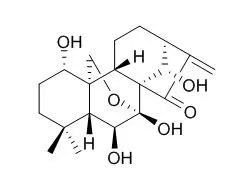| In vitro: |
| Sichuan Da Xue Xue Bao Yi Xue Ban. 2014 Nov;45(6):903-7. | | Anti-leukemia effect of oridonin on T-cell acute lymphoblastic leukemia[Pubmed: 25571712] | To investigate the antileukemia effect of Oridonin on T-cell acute lymphoblastic leukemia cell line CEM.
METHODS AND RESULTS:
Human T-cell acute lymphoblastic leukemia cell line CEM was cultured in vitro. The 50% inhibition concentration (IC50) of Oridonin against CEM cells was examined using modified MTT assay. The cellular morphologic changes were observed using a light microscope. The percent of apoptosis of CEM cells after drug treatment was evaluated by flow cytometric analysis. The active levels of AKT/mTOR, RAF/MEK/ ERK, STAT5 signaling pathways and the expression levels of Bcl-2 and BAX were examined by Western blot.
Oridonin inhibited the growth of CEM cells in time- and dose dependent manner and the ICs0 of Oridonin was (7. 37± 1. 99) μmol/L after 72 h treatment. The cellular membrane of CEM cells treated with Oridonin became unsharp, some of them disintegrated. Oridonin induced apoptosis in CEM cells and the percent of apoptosis rate after 0, 5, 7.5, 10 μmol/L Oridonin treatment for 24 h were (4. 8±2. 11)%, (19.03±12.54)% ,(40.27± 3.31) / and (57. 23 ± 6. 69)% respectively. Oridonin inhibited activation of mTOR, P70S6, 4EBP1, RAF. ERK and STAT5 signaling protein, which were constitutively activated in CEM cells, however, Oridonin had no inhibitory effect on AKT kinase. Oridonin down-regulated the level of anti apoptotic protein Bcl-2 and up-regulated the expression of pro-apoptotic protein Bax.
CONCLUSIONS:
Oridonin exerted antileukemia effect in CEM cells by inhibiting the activation of mTOR/P70/4EBP1, RAF/ERK and STATS signaling pathways, down-regulating the expression of Bel-2 and up-regulating the expression of BAX. | | Zhong Yao Cai. 2014 Jul;37(7):1230-3. | | Experimental study on anti-pancreatic cancer effect of oridonin.[Pubmed: 25566662] | To investigate the apoptotic effect of Oridonin in human pancreatic cancer cells PANC-1, and to explore the underlying mechanism.
METHODS AND RESULTS:
MTT assay was used to measure the cell viability. Apoptosis was determined by confocal laser scanning microscope after Hoechst 33342 staining and flow cytometry analysis after PI staining. The regulation of JNK and p38 MAPK signaling pathway proteins was examined by Western blot analysis.
Treatment with Oridonin for 24 h resulted in a marked decrease in cell viability in a dose-dependent manner. The IC50 value was determined as 49.80 μmol/L for 24 h. After treatment with 50 micromol/L and 80 μmol/L Oridonin for 24 h, typical apoptotic nucleus alterations were observed with confocal laser scanning microscope and apoptotic rates of PANC-1 cells increased by flow cytometry analysis. Treatment with 80 μmol/L Oridonin down-regulated protein expression of JNK, p38 and increased the expression of p-JNK, p-p38. Furthermore, 80 μmol/L Oridonin treatment decreased the expression of down-stream proteins Caspase-9, Caspase-3 and PARP in the apoptotic pathway as well as activated the cleavage of Caspase-9.
CONCLUSIONS:
Oridonin can induce apoptosis of PANC-1 cells through JNK and p38 MAPK pathway proteins. | | Mol Cancer Ther . 2018 Jul;17(7):1540-1553. | | Targeting AKT with Oridonin Inhibits Growth of Esophageal Squamous Cell Carcinoma In Vitro and Patient-Derived Xenografts In Vivo[Pubmed: 29695636] | | Abstract
Overexpression or activation of AKT is very well known to control cell growth, survival, and gene expression in solid tumors. Oridonin, an inflammatory medical and diterpenoid compound isolated from Rabdosia rubescens, has exhibited various pharmacologic and physiologic properties, including antitumor, antibacterial, and anti-inflammatory effects. In this study, we demonstrated that Oridonin is an inhibitor of AKT and suppresses proliferation of esophageal squamous cell carcinoma (ESCC) in vitro and in vivo The role of AKT in ESCC was studied using immuno-histochemical analysis of a tumor microarray, the effect of AKT knockdown on cell growth, and treatment of cells with MK-2206, an AKT inhibitor. Oridonin blocked AKT kinase activity and interacted with the ATP-binding pocket of AKT. It inhibited growth of KYSE70, KYSE410, and KYSE450 esophageal cancer cells in a time- and concentration-dependent manner. Oridonin induced arrest of cells in the G2-M cell-cycle phase, stimulated apoptosis, and increased expression of apoptotic biomarkers, including cleaved PARP, caspase-3, caspase-7, and Bims in ESCC cell lines. Mechanistically, we found that Oridonin diminished the phosphorylation and activation of AKT signaling. Furthermore, a combination of Oridonin and 5-fluorouracil or cisplatin (clinical chemotherapeutic agents) enhanced the inhibition of ESCC cell growth. The effects of Oridonin were verified in patient-derived xenograft tumors expressing high levels of AKT. In summary, our results indicate that Oridonin acts as an AKT inhibitor to suppress the growth of ESCC by attenuating AKT signaling. Mol Cancer Ther; 17(7); 1540-53. ©2018 AACR. |
|






 Cell. 2018 Jan 11;172(1-2):249-261.e12. doi: 10.1016/j.cell.2017.12.019.IF=36.216(2019)
Cell. 2018 Jan 11;172(1-2):249-261.e12. doi: 10.1016/j.cell.2017.12.019.IF=36.216(2019) Cell Metab. 2020 Mar 3;31(3):534-548.e5. doi: 10.1016/j.cmet.2020.01.002.IF=22.415(2019)
Cell Metab. 2020 Mar 3;31(3):534-548.e5. doi: 10.1016/j.cmet.2020.01.002.IF=22.415(2019) Mol Cell. 2017 Nov 16;68(4):673-685.e6. doi: 10.1016/j.molcel.2017.10.022.IF=14.548(2019)
Mol Cell. 2017 Nov 16;68(4):673-685.e6. doi: 10.1016/j.molcel.2017.10.022.IF=14.548(2019)